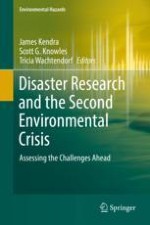2019 | OriginalPaper | Chapter
Disaster Studies at 50: Time to Wear Bifocals?
Author : Ben Wisner
Published in: Disaster Research and the Second Environmental Crisis
Publisher: Springer International Publishing
Activate our intelligent search to find suitable subject content or patents.
Select sections of text to find matching patents with Artificial Intelligence. powered by
Select sections of text to find additional relevant content using AI-assisted search. powered by
